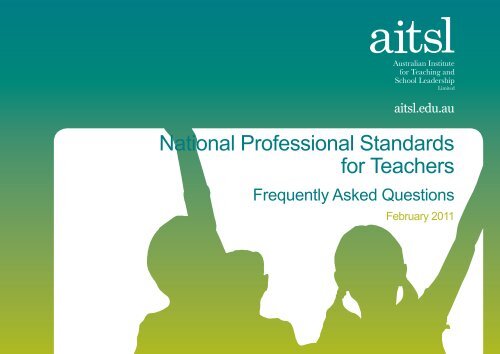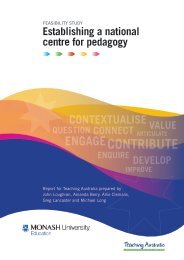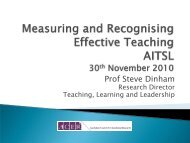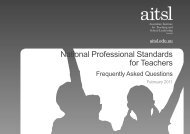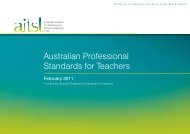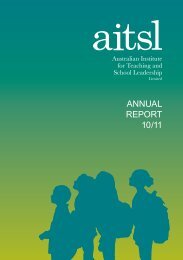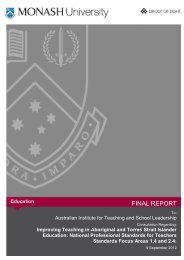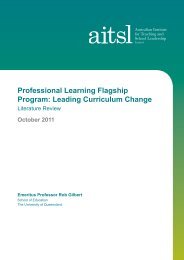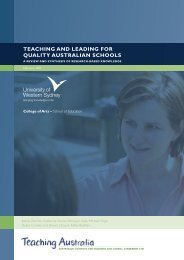National Professional Standards for Teachers - AITSL, Australian ...
National Professional Standards for Teachers - AITSL, Australian ...
National Professional Standards for Teachers - AITSL, Australian ...
Create successful ePaper yourself
Turn your PDF publications into a flip-book with our unique Google optimized e-Paper software.
aitsl.edu.au<strong>National</strong> <strong>Professional</strong> <strong>Standards</strong><strong>for</strong> <strong>Teachers</strong>Frequently Asked QuestionsFebruary 2011
Frequently Asked Questions1. What are the <strong>National</strong><strong>Professional</strong> <strong>Standards</strong> <strong>for</strong><strong>Teachers</strong>?The new <strong>National</strong> <strong>Professional</strong> <strong>Standards</strong> <strong>for</strong><strong>Teachers</strong> make explicit what effective teachersshould know and be able to do.The <strong>Standards</strong> describe what is expected ofteachers across three domains: <strong>Professional</strong>Knowledge, <strong>Professional</strong> Practice and<strong>Professional</strong> Engagement; and at fourcareer stages: Graduate, Proficient, HighlyAccomplished and Lead.The <strong>Standards</strong> and their descriptors representan analysis of effective, contemporarypractice by teachers throughout Australia.Their development included a synthesis of thedescriptions of teachers’ knowledge, practiceand professional engagement used by teacheraccreditation and registration authorities,employers and professional associations. Eachdescriptor has been in<strong>for</strong>med by teachers’understanding of what is required at differentstages of their careers. An extensive validationprocess involving almost 6,000 teachersensured that each descriptor was shaped by theprofession.The <strong>Standards</strong> are designed to provide acontinuum of capabilities and expectations anda nationally consistent basis <strong>for</strong> valid, fair andreliable identification and recognition of theteachers who meet them.2. Why national <strong>Standards</strong>?Education systems are working in a new contextof collaboration and national agreement acrossthe country. The <strong>National</strong> Partnership onImproving Teacher Quality, in particular, setsnew challenges in terms of national consistencyof teacher <strong>Standards</strong>, teacher registrationand accreditation of initial teacher educationprograms to support teacher mobility and cooperativeef<strong>for</strong>ts to learn from each other toimprove quality even further.<strong>National</strong> <strong>Standards</strong> will provide consistentbenchmarks to help teachers assessper<strong>for</strong>mance, identify further learningrequirements and will provide a means ofidentifying and recognising teachers who excelagainst the national <strong>Standards</strong>.The national consistency inherent in the<strong>Standards</strong> will contribute to the ease of mobilityof the <strong>Australian</strong> teaching work<strong>for</strong>ce. The<strong>Standards</strong> will increase public confidencein the professionalism of teachers,providing a public statement of whatparents and the community can expectof effective <strong>Australian</strong> teachers.3. What is the purpose ofstandards?<strong>Professional</strong> standards are a public statement ofwhat constitutes teacher quality. They presenta common understanding and language <strong>for</strong>professional discussions between teachers,principals, teacher educators, professionalassociations and the public.<strong>Standards</strong> provide a framework that offers adirection and structure to guide the preparation,support and development of teachers. Theyreflect a continuum of a teacher’s developingprofessional expertise, from undergraduatepreparation to being a leader in the teachingprofession. <strong>Standards</strong> are intended to supportteachers’ career-long development. <strong>Teachers</strong>can use the <strong>Standards</strong> to recognise theircurrent and developing capabilities, professionalaspirations and achievements.Because the <strong>Standards</strong> are explicit andpublic they allow teachers to demonstratelevels of professional knowledge,professional practice and professionalengagement. In this way teacherstandards contribute to theprofessionalisation of teachingand raise the status of theprofession.<strong>National</strong> <strong>Professional</strong> <strong>Standards</strong> <strong>for</strong> <strong>Teachers</strong> 2.
Frequently Asked Questions4. How will the <strong>National</strong> <strong>Professional</strong> <strong>Standards</strong><strong>for</strong> <strong>Teachers</strong> be used?The <strong>National</strong> <strong>Professional</strong> <strong>Standards</strong> <strong>for</strong> <strong>Teachers</strong> are a centrepieceof national re<strong>for</strong>ms being implemented under the <strong>National</strong> Partnershipon Improving Teacher Quality and will be used by all employers andregulatory authorities, with progressive implementation to be determinedin jurisdictions following appropriate consultation and the development ofsupport material.The <strong>Standards</strong> align with the career pathways of the teaching professionand <strong>for</strong>m the basis <strong>for</strong> attracting, preparing, developing and supportingteachers. Through this alignment, the <strong>Standards</strong> will be used to <strong>for</strong>m thebasis <strong>for</strong>;• accrediting initial service teacher education programs;• reliable, fair and nationally consistent registration; and• recognising and certifying exemplary teacher practice.The Graduate and Proficient career stages of the <strong>Standards</strong> aremandatory. These set out the requirements <strong>for</strong> entry to the profession - <strong>for</strong>beginning teachers to gain provisional registration and <strong>for</strong> teachers withthe requisite experience to gain full registration.The Highly Accomplished and Lead levels of the <strong>Standards</strong> are voluntary:that is, teachers may choose to be assessed against these <strong>Standards</strong> butare not required to do so.5. What are the components of the <strong>Standards</strong>?The <strong>Standards</strong> identify what is expected of teachers across three domainsof teaching:• <strong>Professional</strong> Knowledge• <strong>Professional</strong> Practice• <strong>Professional</strong> EngagementThe <strong>Standards</strong> comprise seven broad statements identifying whatteachers should know and be able to do. The <strong>Standards</strong> are:Standard 1:Standard 2:Standard 3:Standard 4:Standard 5:Standard 6:Standard 7:Know students and how they learnKnow the content and how to teach itPlan <strong>for</strong> and implement effective teaching and learningCreate and maintain supportive and safe learning environmentsAssess, provide feedback and report on student learningEngage with professional learningEngage professionally with colleagues, parents/carers and thecommunityDescriptors identify the components of the <strong>Standards</strong> at four careerstages:• Graduate <strong>Teachers</strong>• Proficient <strong>Teachers</strong>• Highly Accomplished <strong>Teachers</strong>• Lead <strong>Teachers</strong><strong>National</strong> <strong>Professional</strong> <strong>Standards</strong> <strong>for</strong> <strong>Teachers</strong> 3.
Frequently Asked Questions6. How have the national<strong>Standards</strong> been developed?This has been an extensive national processdrawing on external research as well as expertknowledge from key educationalists acrossAustralia.In 2010, under the auspice of the <strong>Australian</strong>Education, Early Childhood Developmentand Youth Affairs Senior Officials Committee(AEEYSOC), a draft of the <strong>National</strong> <strong>Professional</strong><strong>Standards</strong> <strong>for</strong> <strong>Teachers</strong> was finalised. Thedraft <strong>Standards</strong> were the subject of extensiveconsultation and a rigorous validation process.Almost 6,000 teachers participated in thisprocess. The analysis of this feedback in<strong>for</strong>medthe final version of the <strong>Standards</strong>.ConsultationStakeholder consultations were designedto provide the opportunity <strong>for</strong> all interestedparties to shape the development, content andstructure of the <strong>Standards</strong>, and in turn to supportlong-term engagement from the teachingprofession. Consultations were conducted withinjurisdictions, through arrangements determinedby jurisdictional authorities, major employingauthorities and teacher regulatory authorities,and <strong>for</strong> stakeholders nationwide (includingteacher unions, professional associations andparent/community groups) by the <strong>Australian</strong>Government.The draft <strong>Standards</strong> were made available onthe Ministerial Council <strong>for</strong> Education, EarlyChildhood Development and Youth Affairs(MCEECDYA) website, which af<strong>for</strong>ded anopportunity <strong>for</strong> interested individuals to makesubmissions.Submissions were received from the <strong>Australian</strong>Government, State and Territory Governmentsand their regulatory authorities, educationunions, professional peak bodies and individualschools and teachers. In total 120 submissionswere received, which included consolidatedand joint submissions as well as thosereceived through the MCEECDYA website fromindividuals and organisations.With the approval of AEEYSOC, the followingin<strong>for</strong>mation can now be found at http://www.aitsl.edu.au/ta/go/home/pid/775:Submissions: Except where those providingthe submission indicated they wishedtheir submission to remain confidential, allsubmissions have been published.Consultation Report: A report on the outcomesof the consultations undertaken between Marchand May 2010 on the draft <strong>National</strong> <strong>Professional</strong><strong>Standards</strong> <strong>for</strong> <strong>Teachers</strong>.Adjunct Paper: A document designed to supportthe new <strong>National</strong> <strong>Professional</strong> <strong>Standards</strong> <strong>for</strong><strong>Teachers</strong> by providing in<strong>for</strong>mation about thecontext in which they have been developed, theprocess through which they were developed, theplan <strong>for</strong> their implementation and the purposes<strong>for</strong> which they may be used.ValidationFollowing the consultation period, the <strong>Standards</strong>went through a rigorous psychometric validationprocess. The validation was conducted <strong>for</strong> the<strong>Australian</strong> Institute <strong>for</strong> Teaching and SchoolLeadership (<strong>AITSL</strong>) by the University of NewEngland’s <strong>National</strong> Centre of Science, ICT,and Mathematics Education <strong>for</strong> Rural andRegional Australia (SiMERR <strong>National</strong> Centre).The validation ensured appropriateness andreliability of the <strong>Standards</strong> with teachersacross primary and secondary schools andgovernment, Catholic and Independent sectors.Authority <strong>for</strong> the <strong>National</strong><strong>Professional</strong> <strong>Standards</strong> <strong>for</strong><strong>Teachers</strong>The draft <strong>Standards</strong> were revised based on theoutcomes of the consultation and validationprocesses. The validated <strong>Standards</strong> werenoted and approved by the Board of <strong>AITSL</strong> andAEEYSOC, and were presented to MCEECDYAin December 2010. The <strong>National</strong> <strong>Professional</strong><strong>Standards</strong> <strong>for</strong> <strong>Teachers</strong> were endorsed byMCEECDYA Out of Session on 22 December2010.<strong>National</strong> <strong>Professional</strong> <strong>Standards</strong> <strong>for</strong> <strong>Teachers</strong> 4.
Frequently Asked Questions7. What do the new <strong>Standards</strong>mean <strong>for</strong> the frameworksdeveloped by professionalassociations?A range of existing standards have previouslybeen developed by various professionalassociations as well as organisations such asTeaching Australia, the predecessor of <strong>AITSL</strong>.The expert working group developing thedraft national <strong>Standards</strong> has in the course oftheir work looked at as many of these existingstandards as possible.The national <strong>Standards</strong> are intended as ahigh-level, over-arching set of standards. Allother standards should align with the <strong>National</strong><strong>Professional</strong> <strong>Standards</strong> <strong>for</strong> <strong>Teachers</strong>.8. How will teachers becomefamiliar with the <strong>Standards</strong>?The <strong>Standards</strong> are available on the <strong>AITSL</strong>website. In<strong>for</strong>mation regarding the <strong>Standards</strong>will also be <strong>for</strong>warded to all employing bodies,regulatory authorities and professionalassociations across all systems and sectors.<strong>AITSL</strong> will work with all systems and sectorsin responding to further Frequently AskedQuestions, and to plan, develop and implementonline modules to acquaint users with the<strong>Standards</strong>.<strong>AITSL</strong> will also work closely with stakeholdersto develop a range of support materials and willelaborate and provide examples of effectivepractice against the descriptors in a range ofcontexts, to support the implementation of the<strong>Standards</strong> across Australia.9. What happens from here?During 2011 <strong>AITSL</strong> will collaborate withjurisdictions, sectors, regulatory authorities,professional associations and unions tosupport the transition to and implementationof the <strong>Standards</strong> in jurisdictions and sectors,taking account of the different industrial,legislative and policy arrangements andpractice in and between jurisdictions andsectors.Principles and frameworks will bedeveloped to guide and support theassessment processes associatedwith the use of the Graduate <strong>Standards</strong> inthe accreditation of initial teacher educationprograms and the Proficient <strong>Standards</strong> in theregistration of teachers, as well as the voluntaryuse of Highly Accomplished and Lead <strong>Standards</strong><strong>for</strong> the certification of teachers.The development and collation of supportmaterials will also be undertaken.10. Must all states andterritories use the <strong>Standards</strong>?Yes.It is expected that, over time, jurisdictions,systems, sectors, regulatory and employingbodies will work with the <strong>Standards</strong> in a range ofways.The Graduate Teacher <strong>Standards</strong> will beadopted throughout 2011 as part of theaccreditation of Initial Teacher EducationPrograms process.The Proficient Teacher <strong>Standards</strong> will be usedas a basis <strong>for</strong> nationally consistent registrationand the <strong>National</strong>ly Consistent TeacherRegistration Policy Framework Group and<strong>National</strong>ly Consistent Teacher RegistrationWorking Group will continue to work withjurisdictions, systems and sectors on theprocesses involved with this.Work that commenced in 2010 regarding thecertification of Highly Accomplished and Lead<strong>Teachers</strong> will continue throughout 2011.<strong>National</strong> <strong>Professional</strong> <strong>Standards</strong> <strong>for</strong> <strong>Teachers</strong> 5.
Frequently Asked Questions11. What happens to our existing<strong>Standards</strong>?Until such time that agreement has beenreached with employers, regulatory authorities,systems and sectors on the processesassociated with the <strong>Standards</strong>, teachers shouldcontinue to work within the existing guidelines,standards and processes that their jurisdictionrequires.Implementation plans will be negotiated withjurisdictions regarding this transition.12. What is the relationshipbetween the <strong>Standards</strong> andper<strong>for</strong>mance management andappraisal?It is expected that in-school per<strong>for</strong>mancemanagement and appraisals processes will useand link to the <strong>National</strong> <strong>Professional</strong> <strong>Standards</strong><strong>for</strong> <strong>Teachers</strong> and supporting documentationdeveloped to in<strong>for</strong>m these processes. Thereis no link between per<strong>for</strong>mance pay, careerstructure and the <strong>Standards</strong> as these aremanagerial and industrial issues to bedetermined within individual jurisdictions, sectorsand employers.13. What is the role of state andterritory regulatory authoritiesand how will they use the<strong>Standards</strong>?The Australasian Teacher Regulatory Authoritiescontinue to play the same role they have in eachjurisdiction. The regulatory authorities havebeen a significant partner in the developmentof the <strong>National</strong> <strong>Professional</strong> <strong>Standards</strong> <strong>for</strong><strong>Teachers</strong> and will be heavily involved in all futurework regarding the development of processes tosupport nationally consistent registration.14. Are teachers expected towork with all of the focus areasand descriptors?The <strong>National</strong> <strong>Professional</strong> <strong>Standards</strong> <strong>for</strong><strong>Teachers</strong> are a public statement of whatconstitutes teacher quality. They define thework of teachers and make explicit the elementsof high quality, effective teaching in 21st Centuryschools which results in improved educationaloutcomes <strong>for</strong> students.Because of this, and the agreed re<strong>for</strong>m areasof the <strong>Australian</strong> Government including closingthe gap <strong>for</strong> Aboriginal and Torres Strait Islanderstudents, improving literacy and numeracyoutcomes <strong>for</strong> all students, the <strong>Australian</strong>Curriculum and the Digital Education Revolution,the inclusion of the following focus areas areparamount to the outcome of improving teacherquality:• strategies <strong>for</strong> teaching Aboriginal and TorresStrait Islander students;• curriculum, assessment and reporting;• literacy and numeracy strategies; and• using ICT safely, responsibly and ethically.<strong>National</strong> <strong>Professional</strong> <strong>Standards</strong> <strong>for</strong> <strong>Teachers</strong> 6.


